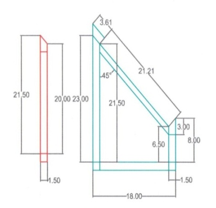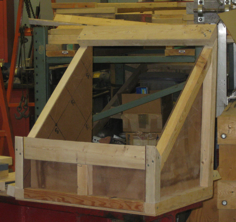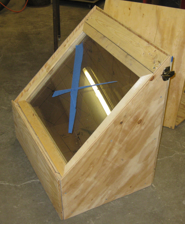...
The team then determined dimensions for an oven that one person can carry, while accommodating three pots. Professor Vanek's oven proved useful for this task, as it can hold three pots and be transported by one person. The interior of the oven was sized such that a small pot could be pushed to the front of the oven and not be impeded by the angled glass cover. A design was produced in AutoCAD to which the team referred throughout construction (Figure 1).
Figure 1: AutoCAD drawings of the Frame
After the dimensions for the oven were determined and the frame was designed, the team needed to determine the essential materials used in the oven. Since this oven will only be used in Ithaca, the team decided to ignore the limitations on materials to those only available in Nicaragua. Materials were chosen that are readily available locally, rather than imitating the materials used in Nicaraguan ovens
The team used 2x4 lumber that was split in half lengthwise to construct the oven's frame. This lumber is easy to come across locally, and happened to be stocked in surplus in the lab. The framing was all connected with coated wood screws available in any hardware store. Fiberglass insulation was used in the cavities of the oven because of its good insulation properties, its compatibility with high temperatures, and its local availability. The inside of the oven is covered with a thin fiberboard which offers some insulating properties as well as structural support for the thin, reflective, metal film attached to the inside of the oven. The team had originally decided to use aluminum sheeting to line the interior of the oven, but a roll of the film was presented to the team and we decided that it would most likely perform better. Double pane glass is used for the oven cover to maximize heat gains and provide better thermal resistance. The small solar oven is depicted in Figure 2 during and after construction.
Figure 2: Oven Frame during Construction and Completed Oven
In addition to designing and building the small solar oven, the team was also working to develop a new design for the prop rods on the ovens currently used in Nicaragua. The current prop rod design consists of a single wooden bar with holes so that the user can select the height and angle of the solar oven's lid. The method for determining a new prop rod design mainly consisted of discussion. There were a variety of factors to consider when designing a new prop rod. Such factors included availability of materials, ease of construction and retrofitting and if the new design would have any impact on how Nicaraguan women used the oven. The final design selected was based off of a prop rod design used on one of the power tools in the Winter Lab (Figure 3).
_Figure 3: Prop Rod_
Results and Discussion
This semester, the small solar oven team set about designing and building two smaller box ovens. We set a tentative schedule as a group, as to when we thought we'd finish each phase of our project, and began work. Looking back at our progress throughout the semester, our team was able to successfully follow our schedule upon completion of each milestone, except for a few instances. The design process took a little longer than expected, but producing a well-thought design before beginning construction proved to be very beneficial down the road, as we did not encounter any major setbacks, or unforeseeable factors. Since we were confident of our design, to make up for the extra time added to the design process, we were able to use the services of a few interested ESW chapter students, who were keen on helping us out. We were able to give them clear instructions on various tasks, while we continued construction and this reduced construction time noticeably. At the end of the semester, we successfully completed one of the ovens, while the other is nearly complete. The second oven will be completed during study week, or by the students in the ESW chapter as the oven is being built for their use.
...




